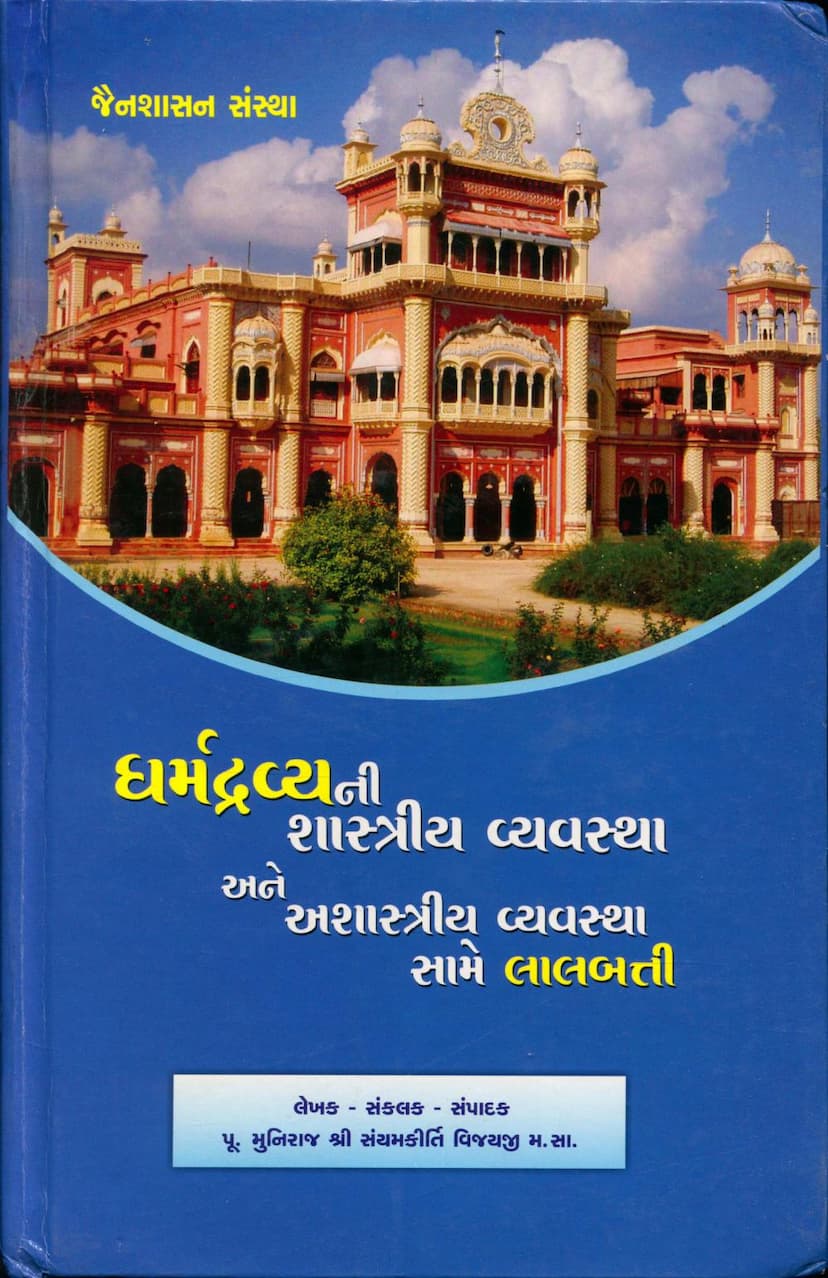Dharmdravyani Shastriya Vyavastha Tatha Ashastriya Vyavastha Same Lalbatti
Added to library: September 1, 2025

Summary
This comprehensive summary outlines the key aspects of the Jain text "Dharmdravyani Shastriya Vyavastha tatha Ashastriya Vyavastha Same Lalbatti" by Sanyamkirtivijay, published by Samyaggyan Pracharak Samiti. The book delves into the "Classical and Non-classical Management of Religious Funds" (Dharmdravya) and raises a "Red Flag" (Lalbatti) against unscriptural practices.
Core Theme: The book critically examines the management of Jain religious funds (Dharmdravya), specifically focusing on Devdravya (funds related to deities/idols/temples), Gurusva (funds for Jain monks/nuns), and Gyana (funds for knowledge/scriptures). It vehemently argues against the deviation from scriptural injunctions and established traditions in managing these funds, highlighting potential misappropriation and the negative spiritual consequences of such actions.
Key Issues and Arguments:
- The Problem of Mismanagement: The central concern of the book is the alleged mismanagement and misuse of religious funds, particularly Devdravya, which are seen as being diverted from their intended scriptural purposes.
- Classical vs. Non-classical Management: The text systematically contrasts the scripturally prescribed methods of managing religious funds (Shastriya Vyavastha) with the perceived unscriptural or deviating practices that have emerged over time (Ashastriya Vyavastha). The author uses the "Red Flag" metaphor to warn against these deviations.
- Focus on Devdravya: A significant portion of the book is dedicated to defining and explaining the proper use of Devdravya.
- Definition of Devdravya: The book clarifies that Devdravya originates from offerings made in the name of deities, temples, and their associated activities.
- Scriptural Use: It emphasizes that Devdravya should be used for the upkeep and development of temples, idols, and related religious services.
- Misuse and Its Consequences: The text warns against misusing Devdravya for personal gain or for purposes not sanctioned by scriptures, citing severe spiritual repercussions, including falling into endless cycles of rebirth and suffering.
- Historical Context and Debates: The book traces the history of these debates within the Jain tradition, referencing events and resolutions from Shraman Sammelans (gatherings of Jain monks) in V.S. 1976 (1919 CE), 1990 (1933 CE), and 2014 (2057 CE). It highlights how these historical forums attempted to uphold scriptural principles against evolving practices.
- Critique of Specific Practices:
- "Boli" (Bidding/Auction): The book discusses the practice of Boli (auctions for religious rights or offerings), arguing that while it has scriptural basis for the growth of Devdravya, its current application and the channeling of its proceeds are often debated.
- Misinterpretation of Scriptures: A major criticism is directed at those who misinterpret or selectively quote scriptures to justify the use of Devdravya for temple maintenance and expenses, thereby potentially diverting it from its core purpose.
- The Concept of Kalpit Devdravya: The text strongly refutes the notion of Kalpit Devdravya (imagined or artificially created religious funds) being used to justify broader temple expenses, arguing that this concept is a distortion of scriptural intent.
- Distinction between Pujya and Pujya-Nirmit Funds: The author distinguishes between funds directly offered for worship (Pujya) and funds generated from temple assets or derived from specific religious rights (Nirmit), stressing that the latter should be managed strictly according to scriptural guidelines.
- Specific examples: The book analyzes various scriptural passages from texts like Upadesh Pad, Shraddh Dinn Krutya, Shraddh Vidhi, Dravya Saptatika, Darshan Shuddhi, and Vasudev Hindi to illustrate the correct and incorrect application of religious funds.
- The Role of Ascetics and Laypersons: The text emphasizes the responsibility of both Jain monks (Munis) and lay followers (Shravaks) in upholding the sanctity and proper management of religious funds. It calls for guidance from knowledgeable ascetics (Gitaarths) who adhere to scriptural principles.
- The Danger of Deviation: The book warns that any deviation from scriptural norms in the management of religious funds can lead to severe spiritual consequences, including falling into lower states of existence and hindering the path to liberation (Moksha).
- Call for Caution and Adherence to Tradition: The author urges the Jain community to remain vigilant against practices that deviate from scriptural traditions, emphasizing the importance of consulting learned scholars and strictly adhering to the established guidelines for religious financial management.
- Emphasis on Swdravya (Own Funds): The book strongly advocates for lay followers to use their own personal wealth for religious observances and temple activities, rather than misusing or misinterpreting religious funds designated for specific purposes.
- Historical Context of Debates: The text highlights that the debates surrounding the management of religious funds are not new and have been addressed by prominent Jain Acharyas and scholars throughout history, particularly in the context of Chaityavasis (temple-dwelling ascetics) and later reform movements.
Key Figures and Texts Referenced:
- Author: Sanyamkirtivijay
- Publisher: Samyaggyan Pracharak Samiti, Ahmedabad
- Referenced Acharyas and Texts: The book draws heavily on the teachings and writings of various Jain Acharyas like Haribhadra Suri, Chandraprabh Suri, Devchandra Suri, Ratnasekhar Suri, Devendra Suri, and others. It also references key Jain scriptures and texts such as Panchashak, Shodashak, Upadesh Pad, Shraddh Dinn Krutya, Shraddh Vidhi, Dravya Saptatika, Darshan Shuddhi, Mool Shuddhi, Sambodh Prakaran, Vasudev Hindi, Lalit Vistara, and Dharmasngrah.
- Historical Sammelans: Resolutions from Shraman Sammelans (V.S. 1976, 1990, 2014) are cited to support the scriptural basis of fund management.
Overall Purpose: The book serves as a cautionary guide and an educational resource for the Jain community, aiming to prevent the misuse of religious funds and ensure adherence to the sacred principles laid down in Jain scriptures and traditions. It is a strong advocacy for scriptural purity in financial dealings within the Jain religious institution.